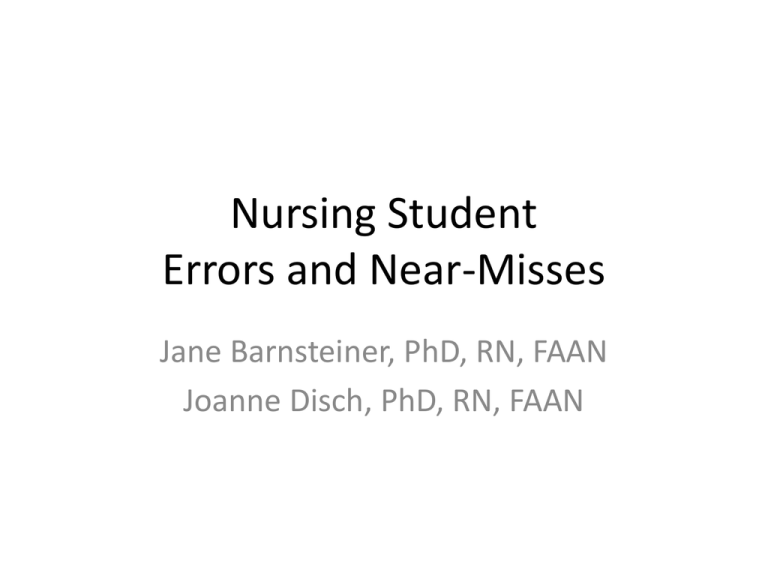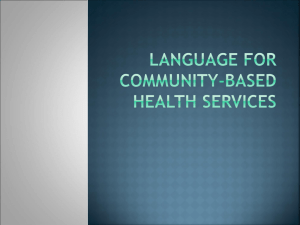
Nursing Student
Errors and Near-Misses
Jane Barnsteiner, PhD, RN, FAAN
Joanne Disch, PhD, RN, FAAN
Objectives
• Review the concepts of high reliability
organizations and just culture
• Apply these concepts to schools of nursing
• Examine preliminary data from a survey of on
policies and tools for tracking nursing student
errors and near-misses
• Identify implications for schools of nursing
Members of the team
•
•
•
•
•
Jane Barnsteiner, PhD, RN, FAAN
Joanne Disch, PhD, RN, FAAN
Judith Warren, PhD, RN, FAAN, FACMI
Susan Connor, MSN, RN (research assistant)
Fabiana Brogren, BA (project administrator)
High Reliability Organizations (HRO)
Safety is dependent upon health care systems
and organizations,
Patients should be safe from injury caused by
interactions with the systems and organizations
of care.
High Reliability Organizations (HRO)
•A culture of safety,
•Foster a learning environment
•Evidence-based care
•Positive working environments
HRO
•Committed to improving the safety
and quality of care
•Transparency
Characteristics of HROs:
Characteristics of HROs include:
– safety and quality-centered culture
– direct involvement of top and middle leadership
– safety and quality efforts aligned with the
strategic plan
– established infrastructure for safety and
continuous improvement
– active engagement of staff across the organization
Just Culture
• Within a culture of safety, when an adverse
event occurs, the focus is on what went
wrong, not who is the problem.
Evolutionary Approaches
• Shame and Blame
• System Errors
• Just Culture
Culture of Blame
A culture of blame has been pervasive in healthcare.
The focus has often been to try to determine who
has been at fault and, all too often, to mete out
discipline.
– leads to hiding rather than reporting errors and is
the antithesis of a culture of safety.
Blame and Shame
• Expectation of perfection
• Finger pointing
– Identify who did it rather than what happened
• Defensiveness
• Fear of
– legal liability
– loss of credibility and reputation
– Punishment
• Secrecy and cover up
Blameless Reporting System
•
•
•
•
Confidential reporting
Voluntary and Anonymous
Transparency of errors and latent conditions
Event analysis
– Guard against blame, attribution and hindsight
bias
• Improvements identified with system of
feedback
• Disclosure and Truth Telling
Blameless Reporting System
•
•
•
•
•
What happened?
Has it happened before?
Could it happen again?
What caused it to happen?
Who should be told?
Managing Healthcare Risk – The Three Behaviors
Normal Error
At-Risk Behavior
Reckless Behavior
Product of our
current
system design
Unintentional
Risk-Taking
Intentional RiskTaking
Manage through:
Manage through:
Manage through
changes in:
• Understanding our atrisk behaviors
• Disciplinary action
• Processes
• Removing incentives for
at-risk behaviors
• Procedures
• Training
• Design
• Environment
Normal Error
• Creating incentives for
healthy behavior
• Increasing situational
awareness
Negligence?
*David Marx – Just Culture
American Association of Colleges of Nursing. © 2010 - All Rights Reserved.
Recklessness
• Cohen (2008): 37% nurses reported that they
had not reported an error that might be
personally or professionally damaging
• Ruitenberg (2002): 50% drop in incident
reports after prosecution of air traffic
controllers who had been involved in nearmiss situations.
What do we know about
schools of nursing?
What is the process when an error takes place
with a student?
– How is the situation analyzed?
– What is the reporting process?
– What if anything is entered into the student file?
– What is the debriefing process with the student?
– What are the discipline decision rules?
– How are errors used as teachable moments
• With other students, if at all?
• With other faculty, if at all?
• Wolfe (2006): national database, MEDMARX –
1300 medication errors and over 5-year period
• Harding (2008): retrospective review of 77 errors
over 3 year period – 43% related to inexperience
in reading the MAR
• Currie et al (2009): 3 years, 453 students, 10,206
‘yes’ responses to hazards (59%) and near-misses
(42%)
• Reid Searle et al (2010): of 28, 9 reported errors
or near-misses, often due to distractions – no
need to report…time-consuming
Barriers to reporting (Pfeiffer, 2010)
•
•
•
•
Attitudes
Concerns about the reporting systems
Not receiving feedback after reporting
Perceptions, e.g., why bother if no harm to
the patient
Purposes of the study
• (1) collect and analyze information on current
practices and policies for reporting and
trending errors and near-misses by prelicensure students in schools of nursing for the
purpose of
• (2) create a national data repository for
tracking and trending errors and near-misses
by nursing students in pre-licensure programs.
Aims
• Conduct a national survey to collect and analyze information from
nursing school faculty on the systems and processes for reporting
and trending errors and near-misses by students.
• Design a web-based tool for reporting student errors and nearmisses that can be used both internally within schools of nursing
and nationally as part of a national data repository.
• Develop a website for communication about the project, and to
present reports on aggregated student errors and near-misses on a
recurring basis.
• Develop educational materials on just culture, the role of errors
and near-misses in improving the quality of nursing education, and
strategies that faculty can adopt in trending and analyzing error and
near-miss data.
Methodology: Phase 1
• National web-based survey of all pre-licensure
nursing programs
– Demographic information
– Presence of
• a policy for reporting and follow up of student errors
and near-misses
• a tool for reporting student errors
• a process and/or tools for trending of errors and nearmisses, and
• strategies for follow-up for support and/or discipline for
faculty or students after an error or near-miss.
Preliminary Results
Sample of names of tools/policies
•
•
•
•
•
•
•
Incident report
Clinical advisement notice
Safety reporting tool – error report
Event discovery report
Violation of policy form
Critical incident report
Student occurrence report
- other names of tools
•
•
•
•
•
•
Student continuous improvement report
Unusual occurrence report
Variance report form
Learner prescription for remediation
Clinical performance learning plan
Medication error reporting form
Strategies for follow-up w/ faculty
•
•
•
•
Discussion in faculty meeting
Weekly report to the program director w f/u
End of semester report
Email/phone call from dean/director with
response required
• Clinical faculty are scored on medication
proficiency like staff nurses
• Course coordinator follows-up
• Errors followed up by faculty, Director of BSN
program, Associate Dean and Dean
Clinical agency reporting
• Filling out agency report
• Faculty/agency rep/student sign a form
• Faculty/staff nurse/student analyze situation
and determine what should be done
• Near misses not discussed with clinical agency
– they’re considered internal educational
matters
Follow-up with student
• Errors do not automatically lead to discipline
• Student completes report on how they will
change behavior so X doesn’t happen again,
and attend remediation lab
• Student counseled by instructor and receives
Unsatisfactory for the week
Another follow-up with student
• Student gets Unsatisfactory for the day; meets
with two full-time 1st or 2nd year instructors
and program head, and written
documentation goes in file…if safety issue is
extreme and resulted in patient demise,
student may be dismissed after first
occurrence
Observations
• Faculty vary greatly as to how to think of
errors and near-misses, and what to do with
them





